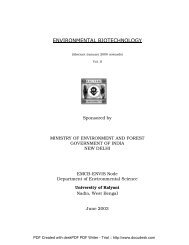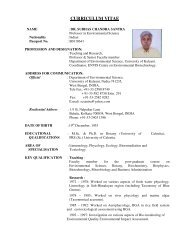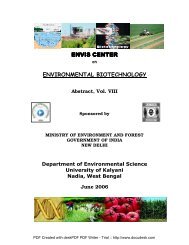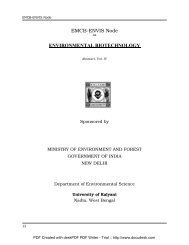EMCB-ENVIS Node ENVIRONMENTAL BIOTECHNOLOGY
EMCB-ENVIS Node ENVIRONMENTAL BIOTECHNOLOGY
EMCB-ENVIS Node ENVIRONMENTAL BIOTECHNOLOGY
You also want an ePaper? Increase the reach of your titles
YUMPU automatically turns print PDFs into web optimized ePapers that Google loves.
<strong>EMCB</strong>-<strong>ENVIS</strong> Centre<br />
"river water test". It was found that only partial degradation took place while pyridinium<br />
chlorides constituted main energy and carbon source. Presence of biodegradation intermediate<br />
products was shown on the basis of 1H NMR analysis. Intermediates were not toxic to any<br />
biotests.<br />
Ewa Liwarska-Bizukojc, Stanislaw Ledakowicz. (Department of Environmental Engineering,<br />
Technical University of Lodz, Al. Politechniki 6, 93-590 Lodz, Poland Author for<br />
correspondence. Department of Bioprocess Engineering, Technical University of Lodz,<br />
Wolczanska 213/215, 93-005 Lodz, Poland). Stoichiometry of the Aerobic<br />
Biodegradation of the Organic Fraction of Municipal Solid Waste (MSW).<br />
Biodegradation, 14(1) (2003), 51-56.<br />
An elemental analysis was applied to describe the composition of the organic fraction of<br />
municipal solid waste (MSW). The initial elemental composition was constant at5H8.5O4N0.2.<br />
The changes of the composition during the biodegradation process and the final waste<br />
composition were strictly dependent on the process conditions. The decrease in carbon content<br />
due to biodegradation increased with temperature at which the experiments were conducted,<br />
from 20% at 20 °C to about 40% at 37–42 °C after 96 hours. It was correlated with the amount of<br />
oxygen that was utilised in the investigated processes of aerobic biodegradation of the waste<br />
suspension. The amount of oxygen required for biodegradation of organic fraction of MSW was<br />
estimated on the basis of stoichiometric equations and increased from 0.92 moles per 1 mole of<br />
waste at 20 °C to 1.6 moles at 42 °C within 96 hours of the experiments.<br />
F Solano-Serena, R Marchal, T Huet, J -M Lebeault, J -P Vandecasteele. (Institut Français<br />
du Pétrole, Département de Microbiologie, 1 & 4 avenue de Bois Préau, 92852 Rueil-<br />
Malmaison Cedex, France. Université de Technologie de Compiègne, Centre de Recherches<br />
de Royallieu, BP 60319, 60203 Compiègne Cedex, France). Biodegradability of volatile<br />
hydrocarbons of gasoline. Applied Microbiology and Biotechnology, 54(1) (2000), 121 –<br />
125.<br />
The biodegradability under aerobic conditions of volatile hydrocarbons (4-6 carbons) contained<br />
in gasoline and consisting of n-alkanes, iso-alkanes, cycloalkanes and alkenes, was investigated.<br />
Activated sludge was used as the reference microflora. The biodegradation test involved the<br />
degradation of the volatile fraction of gasoline in closed flasks under optimal conditions. The<br />
kinetics of biodegradation was monitored by CO2 production. Final degradation was determined<br />
by gas chromatographic analysis of all measurable hydrocarbons (12 compounds) in the mixture<br />
after sampling the headspace of the flasks. The degradation of individual hydrocarbons was also<br />
studied with the same methodology. When incubated individually, all hydrocarbons used as<br />
carbon sources, except 2,2-dimethylbutane and 2,3-dimethylbutane, were completely consumed<br />
in 30 days or less with different velocities and initial lag periods. When incubated together as<br />
constituents of the light gasoline fraction, all hydrocarbons were metabolised, often with higher<br />
velocities than for individual compounds. Cometabolism was involved in the degradation of<br />
dimethyl isoalkanes.<br />
Flemming Ingerslev, Bent Halling-Sørensen. (Institute of Pharmaceutical and Analytical<br />
Chemistry, Section of Environmental Chemistry, Royal Danish School of Pharmacy,<br />
Universitetsparken 2, Copenhagen, DK-2100, Denmark). Biodegradability of<br />
Metronidazole, Olaquindox, and Tylosin and Formation of Tylosin Degradation<br />
Products in Aerobic Soil–Manure Slurries. Ecotoxicology and Environmental Safety,<br />
48(3) (2001), 311-320.<br />
The use of veterinary drugs (primarily antibiotics) in animal husbandry harbors the risk that<br />
these compounds end up in the farmland when manure is used as fertilizer. The biodegradability<br />
of three compounds, olaquindox (OLA), metronidazole (MET), and tylosin (TYL), was<br />
54<br />
PDF Created with deskPDF PDF Writer - Trial :: http://www.docudesk.com







